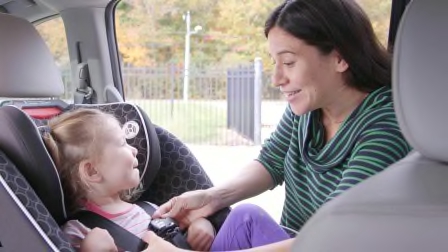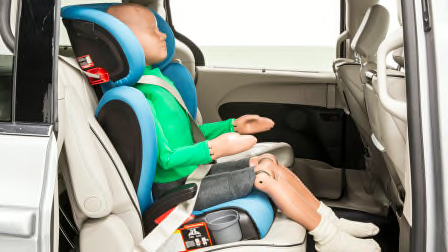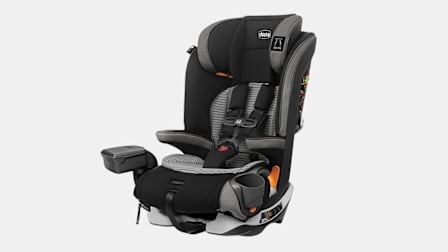Best Booster Seats for Kids
Our experts test dozens of booster seats for safety, belt fit, and much more.
When you shop through retailer links on our site, we may earn affiliate commissions. 100% of the fees we collect are used to support our nonprofit mission. Learn more.

Children pass many milestones during their early years, including going from an infant car seat to sitting independently with a seat belt. A key step on that journey is a booster seat, which gives your child enough height to position the car’s seat belt most effectively.
According to the National Highway Traffic Safety Administration’s car seat guidelines, children are ready to graduate from their forward-facing car seat to a booster seat once they reach the top of the manufacturer’s weight or height limits, whichever comes first. Even though this can feel like big-kid territory, it’s important to remember that children should still be sitting in the back seat once they’re in a booster. Your child will continue using a booster until they’re big enough to fit the main seat belt properly, which usually happens sometime between ages 8 and 12.
Best Highback-to-Backless Booster Seats
Highback-to-backless booster seats feature bolsters around the head and the torso, which provide additional comfort and side impact protection for kids. With these models you can also remove the back, turning the seat into a backless booster perfect for travel or storage.
Best Highback-Only Booster Seats
Highback booster seats are great if any of the seating positions in your car’s back seat don’t have a head restraint, as they provide head and neck support in case of a rear collision.
Best Backless-Only Booster Seats
Backless boosters are good options for travel, or if your vehicle has rear head restraints that can’t be adjusted or cause interference with a highback booster. You can use these booster seats for children who surpass the weight or height limits allowed by their harnessed car seat.
How CR Tests Booster Seats
In the CR lab, we tested more than 40 different booster seats from popular brands, including Chicco, Nuna, Peg Perego, and others. Of particular importance for our testers was proper seat belt fit, which is crucial for booster seat safety. We checked belt fit in five vehicles with different seating and belt geometries. (The shoulder belt should cross the middle of the collarbone and sternum, and the lap belt should sit across the upper thighs.)
In our fit-to-vehicle evaluations, we also simulate typical child movement by moving a dummy around to determine whether the belt remains in place. We also rate each booster for how easy it is to use, which includes an evaluation of its labels and instructions.
Finally, we assigned each booster seat an Overall Score between 0 and 100.
What Are the Different Kinds of Booster Seats?
As the name suggests, all booster seats are designed to “boost” your child up so a seat belt can fit correctly over his or her hips and chest. But there are a few different types of boosters you can consider: The right booster seat for you will depend on your personal preferences, your vehicle, as well as how portable (or not) you need a booster to be.
Highback booster seats, also sometimes simply referred to as booster seats with a high back, have a structure that’s more similar to a forward-facing car seat. These seats lift your child up while also providing head and neck support, so they’re a good choice for cars that don’t have a built-in head restraint. In the event of a rear collision, your child will have extra support with this kind of booster.
Highback-to-backless booster seats have bolsters around the head and torso to provide additional comfort and side impact protection. But with these types of booster seats, you can also remove the back, turning the seat into a backless booster that’s easy to store or take with you on the go.
Backless booster seats are sold without any head and neck support. If you’re looking for a booster seat to use exclusively for travel, for example, these can be a good option. They also work well in cars where the rear head restraints interfere with a highback booster.
When Should Kids Switch to a Booster Seat?
Children can graduate to a booster seat once they meet either the weight or height limit on their forward-facing car seat. If you’re not sure, check the car seat manufacturer’s website or the label. This means that the right age to switch to a booster seat will depend on your child’s weight and/or height, but most kids are able to continue using their forward-facing car seat until sometime between ages 4 and 7. Once your child is ready for a booster, remember that they should still sit in the back seat.
When Do Children Stop Using Booster Seats?
The National Highway Traffic Safety Administration says children should continue using booster seats until they’re big enough that the car seat’s regular seat belt fits properly. The right age for this varies, but most kids are able to switch to a seat belt sometime between the ages of 8 and 12, according to the NHTSA. In order for it to fit correctly, the lap belt should lie snugly across your child’s upper thighs and the shoulder belt across the shoulder and chest. (And again, even once your child is in the seatbelt stage, he or she should continue sitting in the back for as long as possible for their safety.)































































